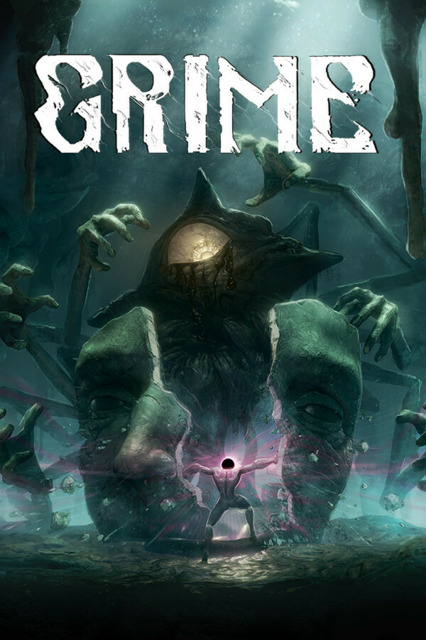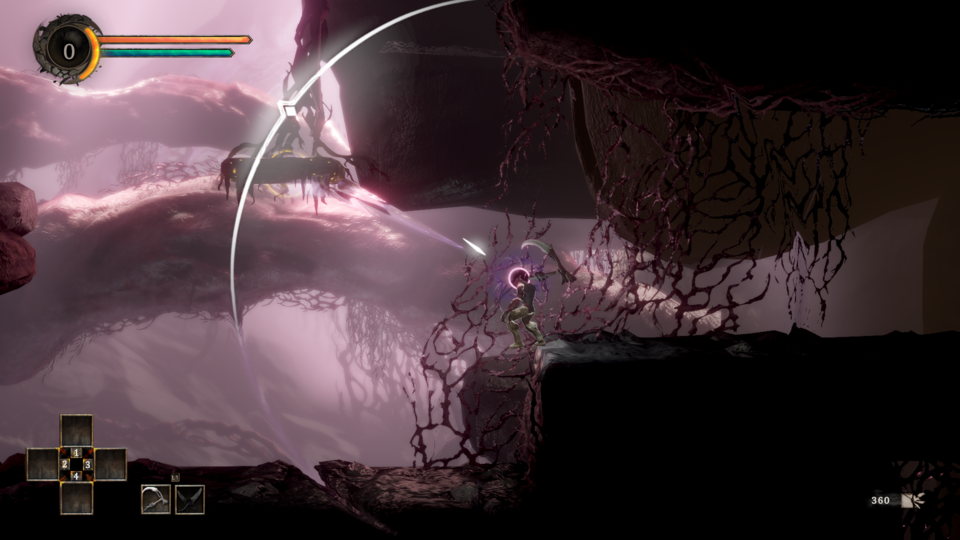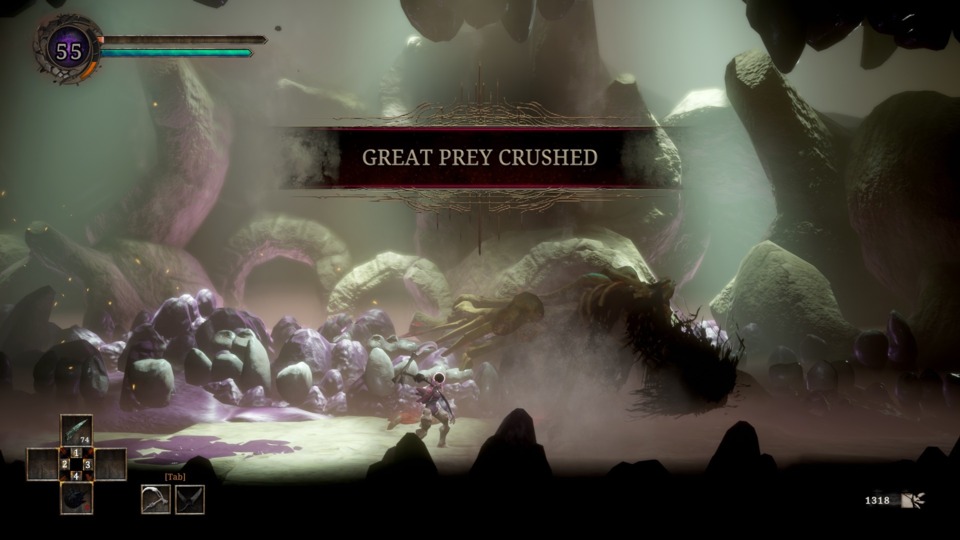Indie Game of the Week 349: Grime
By Mento 0 Comments

Another week, another IGotW covering an explormer. You can set your clocks to it by this point. But hey, I can't help but be drawn to what I like. Not that Grime qualifies just yet, but I suppose it still has time to right the ship. Grime is one of those Soulsian-adjacent 2D explormers that have picked up speed in recent years with the likes of Salt and Sanctuary, Hollow Knight, Blasphemous and others, and I can't imagine them slowing down after Elden Ring broke into the mainstream in a majorly unexpected way (first Elden Ring, now Baldur's Gate 3; are stupidly complex RPGs coming up in the world or what?). You control... a rock guy? With a black hole for a head? And yet somehow you aren't the strangest thing down here. A civilization of stone people, organized into a loose caste system based on their proximity to the human form (not that any humans exist, as far as I can tell), and praising nebulous entities that might be gods or devils, you're tossed into one of the lower echelons and must fight your way towards achieving... something. As I said, it's riffing on Souls, so story details are sparse to non-existent. All that matters is that a lot of things want you dead and that's all the cause you need to make them dead first.
Grime comes out swinging with a pretty layered combat system that quickly takes center stage once it's done introducing all its facets. Enemy health bars are comprised of grey zones and red zones, often a mixture of the two. Grey health needs to be chipped away at with regular attacks, but red health can be instantly demolished with a parry (parries instead do minor damage to grey health). Parries are therefore extremely central to the combat of this game, as they offer not only a means to end fights quickly but are one of the few ways the player can earn enough life juice, called "breath", to heal themselves. That said, you need four of these fatal parries for enough breath for one heal and the healing items are even harder to come by than that, so most of the time your current health bar is all you're going to get. That'd be fine if enemies didn't hit like bulldozers but no such luck there. There's also an i-frame dash that receives a mid-air version around the middle of the game, but both it and attacks use the stamina bar and it drains darn quick depending on the weapons you're using. Point being, you're going to have to learn to not take damage because progress is going to be as slow as molasses otherwise.

There's also another reason you'll want to parry enemies to death (besides it looking cool) and that's the way the game's passive skill system works. Whenever you score one of these parries, called "absorbs" due to how they drain enemies of their essence, you also gain passive skills that you can invest points into. These points are only earned from bosses and mini-bosses so they've both rare and tricky to acquire. Some of these passives are more valuable than others, usually with a concomitant higher point amount to unlock them, so it's been worth getting the timing right on these parries to acquire more to choose from. To reiterate, it's going to be much harder to get anywhere with this game if you're not a parry master; I've never seen a game double-down on them quite this much, but then maybe Grime sees itself as a "Souls Veteran's Soulslike". Beyond that you have equipment but it'll need some heavy upgrading before any weapons become all that strong, which means choosing to focus on upgrading an early-game weapon for something beefy to rely on or holding off on using up your precious materials until a better mid- to late-game weapon comes along. As with most any Souls games there's a decent amount of parity between the weapon types available, giving you a mix of speed, power, reach, and the effectiveness of a special attack exclusive to each weapon. Worth some experimentation whenever you pick a new one up; you can even try out weapons you don't have the stats to qualify for, though you'll only do minimal damage until you pump up those rookie numbers.
Grime is definitely on the upper end of the difficulty scale when it comes to games of its type, to an unnecessarily harsh degree even. However, Grime is also at least somewhat conscious of how punishing it is and so one small balm can be found in its interpretation of the time-honored Soulsian "corpse run" system. You don't lose any currency ("mass") leaving a cadaver behind; instead, all dying does is cause your mass multiplier ("ardor") to reset to zero but it can be recovered to half (or full, if you have the right upgrade) of what you had if you successfully track down where you died. This means there's no rush to spend your currency and you can hang on to it until it's needed, either pouring it into level-ups for marginal gains that might give you an edge over a tough boss or area, or grabbing useful gear and consumables at vendors. Sadly, Grime's quality-of-life benefits start and end there: there's a distinct lack of user friendliness that extends beyond simply the brutal combat, trap-laden exploration, and lack of healing opportunities. For instance, there's only a few places in the world where you can fast travel to—unless, of course, you feel like defeating a special DLC boss that is close to end-game level tough. The map of any given area is concealed until you locate a special beacon somewhere within that zone, but it's usually fairly far inside so most of the time you've only got a footprint trail on the map to remember where you've been (which of course vanishes over time or if you quit the game). On at least one occasion the beacon only appeared after I'd defeated the boss of the area in its deepest part. Though it's been patched out now, the game even had cases where you could permanently miss specific bosses or vendors and the helpful rewards they had to offer.

Little antagonistic touches like these do nothing to endear Grime to me and it has long since begun to feel like the game is difficult and inconvenient for the sake of annoying its players for some perceived slight far more than wanting to provide them an entertaining challenge. I call this the Surly Dungeon Master Effect: sometimes, the DM remembers that everyone's gathered around the table with their rulesets and dice to have a great time with friends and works to accommodate them like a good host should without also taking it too easy on them, but sometimes the DM has suffered one too many of the demoralizing travails that make up daily life and just takes it out on everyone and now it's suddenly an awkward free-for-all where no-one's enjoying themselves and at least one person suddenly remembers that they've got to get up early the following morning and bails out the window. (For the record, I have been neither of these people, but I've seen it happen enough times to know it's A Thing.) Grime is not a good time. It's happy to welcome you into its many circles of hell if taking on nightmare bosses and punitive world design is how you get your kicks, but expect some cask-strength level BS throughout your stay and very little in the way of mercy or hospitality. Currently, I'm stuck in one of those aforementioned DLC areas—despite the added difficulty of this post-game DLC content, they're just sprinkled around the map wherever for you to unfortunately bump into—with no obvious escape route and am left contemplating if it's even worth it to continue. That's always a good place to be with any game. At least it looks nice? In an ugly sort of way?
Rating: 4 out of 5.
Mid-Playthrough Edit: I got over my grudge pretty quick, killed that one guy that unlocked the fast-travel warp (eventually), and now I'm back to enjoying the game again. Just wanted to let you know before I got around to the usual post-playthrough edit. Bumped it up from a 3 to a 4 in the meanwhile. It really is a demanding game, but my obstinate soul burns for such things it turns out.
Post-Playthrough Edit: Woof, yeah. Once I had a few more tools under my employ, the end-game wasn't quite as insurmountable as the early game. Even with some exacting platforming and bosses that hit absurdly hard towards the finale, I could still count on two hands the number of attempts those bosses took. That's not an admonishment of the game's screwy difficulty curve: things really do get much easier with a few more traversal skills and semi-deep character/equipment upgrading to tinker around with. Man, though some of the sights in this game (especially the last) were just breathtaking; it fully commits to its grody "world of weirdo rock monsters on its way out" aesthetic and earns its slow creep of a Soulsian "here's what's actually going on" narrative conclusion. Nothing too revolutionary, but color me impressed with this one. Certainly more than when I wrote this (occasionally petty, in retrospect) review.
| < Back to 348: Q.U.B.E. 2 | 001-100 | 101-200 | 201-300 | > Forward to 350: The Forgotten City |
